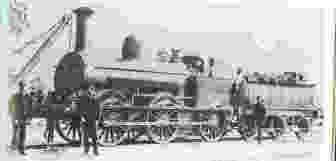|
The London and North Western Railway connected London to all the major manufacturing centres and ports of England and Wales and provided services to Scotland, Ireland and America via Carlisle, Holyhead and Liverpool. It claimed to be the largest joint stock company in the world. It referred to itself as 'The Premier Line' and boasted that its track was the finest permanent-way in the world. It employed 80,000 people, operated 3,000 locomotives and, in its 76 years of existence, never paid a dividend of less than 4% to its shareholders. Francis William Webb was appointed Chief Mechanical Engineer in 1871 in succession to John Ramsbottom. Both believed in standardisation and mass production and under their guidance the Company manufactured 'in- house' almost everything it required from locomotives to bricks. They provided the Company with a stock of cheap, simple and efficient passenger and freight locomotives, some of which survived to become the property of British Railways. Webb also pursued the goal of reduced running costs by the use of 'compounding' - using steam twice before it is exhausted up the chimney. His various classes of compound passenger and goods locos were of doubtful merit and were rapidly scrapped or modified after his retirement in 1903. The model depicts a small LNWR steam shed and is intended to display the range of loco classes and types that were operating in 1901. The track plan is based on Widnes in Lancashire, but the setting is imaginary. The double track main line passing the shed carries eight typical passenger and freight trains of the period :- Two main line expresses A local passenger train Two mineral trains A freight train made up of wagons from other railways A train of LNWR freight wagons A private train such as a member of the aristocracy might have hired to convey his family, servants and accoutrements to Scotland for the "Season". All the locos and rolling stock and most of the buildings are built from kits, some being considerably modified. And by now you way be asking: "Why 1901?" Well, for three reasons. Firstly it was 100 years before I started to build the layout; secondly my father was born then; and thirdly his father went off to fight in the Boer War. So it is a significant year in my family history. If you are interested in any aspect of the LNWR you will benefit greatly by joining the London and North Western Railway Society. For details go to :-http://www.lnwrs.org.uk
|
John Ramsbottom Born 1814 Died 1897 Chief Mechanical Engineer from 1857 until 1871 LNWR Society collection |
|
A 'DX' class 0-6-0 designed by John Ramsbottom. No less than 943 of these locos were built
between 1858 and 1872, an early example of mass production. The last one was withdrawn
in 1930. |
|
|
Francis William Webb Born 1836 Died 1906
Chief Mechanical Engineer from 1871 until
1903 |
|
|
Two of F.W.Webb's
3-cylinder compounds heading a Scotch express in 1899 |



